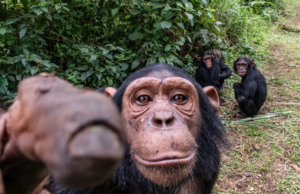Almost human, by Alfred Fidjestøl: the story of Julius, the chimpanzee caught between two worlds

Book review by Alyson Baker*
Almost human is the biography of Julius, a chimpanzee who was born on Boxing Day 1979 in the Kristiansand Zoo, Norway, and who is now the alpha male of the zoo’s chimpanzee community. He was born to Sanne, similarly born in captivity and with no idea how to be a mother, so Julius was taken from the other chimps to save his life and was raised by the families of the zoo’s director (Edvard Moseid) and the zoo’s doctor (Billy Glad), with keeper Ǻse Gunn Mosvold being a major figure for Julius when he visited the zoo.
The foster families knew of the dangers of raising chimps among humans, but regardless of the families swapping Julius around and taking precautions such as frequently taking Julius back to the zoo, he was bound to bond to his ‘families’ and adopt behaviours that made him a misfit amongst his own kind. He is a perfect example of how, when chimps enter human society, their relationships with humans alter their chimp natures. Things sort of turned out OK for Julius, but only at the cost of considerable tragedy and loss of chimp lives. It is true he ended up better off than his half-brother Ola, who was sent to Sweden where he also became a star, but Ola ended up in a cement cage in a zoo in Thailand.
After taking him from the Kristiansand community, the plan was always to reintegrate him, but one thing the book makes clear is the difficulties of reintegrating chimps into captive communities, especially maturing males. The various attempts at reintegration included medicating other chimps to curb their behaviour, and even euthanising healthy adult males to maintain peace in the community. There is no question that Mosvold and Glad and their families cared deeply for Julius, but his story highlights the unnatural and cruel aspects of keeping chimps in captivity.
The juxtaposition of Julius’ difficulties with his public persona is skilfully done: “It was as if two versions of Julius now existed and had parted ways, each living out their own separate lives”: Julius the chimp who became the darling of Norwegian media, and of every Norwegian child growing up in the 1980s / Julius the chimp often left sobbing in isolation, who became ‘dysfunctional and dangerous’, and who epitomises the tragedy of captive chimpanzees.
While the challenges of Julius’ reintegration are described, there are the parallel press stories of birthday parties, painting successes, romance and marriages – anything that “made for good television”, plus the production of a range of Julius merchandise. Julius brought thousands to the zoo, including celebrities and royalty, and made lots of money for the commercial enterprise. And with this high exposure there are some genuinely scary moments, such as when Julius escapes into the public part of the zoo, putting people at risk – the zoo always maintains that all is well, but you read how closely they came to catastrophe.
There is a third story in Almost human, the terrible situation chimps now face in the wild, with poaching, habitat loss and exposure to human disease. Fidjestøl presents Jane Goodall’s view that many wild chimpanzees live in ruined natural conditions and in such constant fear of humans that they might be “better off in modern zoos”. Public zoos have come a long way, with some believing now they are the only hope for the preservation of some species, but what sort of enclosure can be designed that gets anywhere near an ideal wild environment?
The book seamlessly moves from Julius’ story to presenting research on chimp behaviour and ecology, both in captivity and in the wild, highlighting the complex experiences that chimps in captivity lose. It talks of research showing that some wild chimpanzee behaviours date back over 2000 years, and how such rich cultural traditions are in real danger of vanishing forever – cultural traditions to which chimps like Julius will never be exposed.
Almost human does not idealise either chimp life in the wild or in captivity, it doesn’t offer any answers to the conundrums of human/chimpanzee relations, but it does skilfully present the chimpanzee problem through the story of one chimp. And Julius’ story continues; earlier this year, after the book was published, Julius became seriously ill after a visitor purposely poisoned him by throwing him a water-bottle laced with narcotics, once again he survived. Almost human is a valuable addition to the growing body of popular works about chimpanzees.
Almost human: the story of Julius, the chimpanzee caught between two worlds by Alfred Fidjestøl; translated by Becky L. Crook. Also published as Almost human: a biography of Julius the chimpanzee. Sydney, N.S.W.: Hachette Australia, 2019.
*Alyson Baker is a Librarian from Nelson, New Zealand. She has always been interested in wildlife and is appalled not only by the predicted rapid path to extinction of so many animals, but also by the way many of them are treated, especially chimpanzees, our closest relatives. Alyson volunteered at the Ngamba Island Chimpanzee Sanctuary, Uganda in 2017. She returned to Ngamba in 2018 and also went chimp tracking in Kibale National Park, and is planning to go back to the sanctuary and visit Budongo Forest Reserve next year.

 Español
Español
 Português
Português








